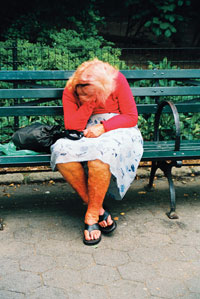Julie Zando analyzes the relationship dynamics among friends, lovers and family. She explores scenarios of subjectivity and sexuality in multivalent expressions of obsession, manipulation, exhibitionism, submission, dependence, voyeurism, masochism, and victimization. Employing still and/or moving images, she combines dramatization and documentary to interpret the complex interactions among narration, psychological description and technological mediation.
The video White Couch presents the story of Eva, a healthy young woman living an average quality life as a civil servant in a big city. One day she finds an emotional letter from her mother expressing remorse and revulsion over the secret life she led as a prostitute while raising Eva. The father, it seems, abandoned the family when Eva was eight, forcing the mother into prostitution to support them. Eva's guilt over her very existence and the extreme burden this imposed on her mother produces such mental and emotional turmoil that it thrusts her into a new sexual and psychological identity. Her obsession to experience her mother's feelings traps her in an imaginary scenario of herself as a prostitute, which she then acts out. Eva's role as author of her new destiny becomes dominant and dictates the characteristics of her new personality. The old Eva becomes chronically depressed and undergoes a rapid aging process in which she also loses autonomy and power. The original civil servant personality gradually withdraws into silence and the Eva that prevails is ready to be punished.
The photographic diptych Park Bench: White Couch is based on Zando's 1989 20-minute b/w silent video White Couch (script written by Josephine Anstey). It investigates the complex mechanisms that maintain the fragile equilibrium of the individual, internally and externally, within society. Zando stages a realistic portrait of Eva's recessive civil-servant personality, shrunk to nothingness, perhaps reflecting too her revised image of her mother, and juxtaposes it with a synthetic, tranquil image evocative of a religious icon, which captures those factors that allowed Eva's new personality to evolve and dominate.

